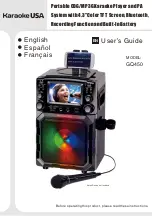
12
www.strata.co.nz
ADVANCEMIG 350 • ADVANCEMIG 500
1.6 Check the wire drive roller (48) grooves match the
selected MIG wire type and size. The drive roller
will have two different sized grooves; the size of the
groove in use is stamped on the side of the drive
roller. For flux cored ‘soft’ wire, such as that used
in gasless MIG welding, the drive roller groove has
a serrated profile (known as knurled). For solid
core ‘hard’ MIG wire, the drive roller groove used
has a ‘V’ shaped profile. For Aluminium solid core
‘soft’ MIG wire, the drive roller required has a ‘u’
shaped groove. If necessary, remove and change
the drive roller by unthreading the drive roller re-
tainer (49).
1.7 Once the correct drive rollers (48) are selected
and fitted, manually feed the wire through the
wire drive inlet guide (50) through the drive roller
grooves and into the brass outlet wire guide tube.
Ensuring that the wire is correctly seated in the
drive roller grooves, replace the wire feed tension
arms (47) and lock them into place by rotating the
wire feed tension adjustment lever (46) back to the
vertical position.
Adjusting wire feed tension: this is accomplished
by winding the knob on the tension adjustment
lever (46). Clockwise will increase tension, anti-
clockwise will decrease drive tension. Ideal tension
is as little as possible, while maintaining a consist-
ent wire feed with no drive roller slippage. Check
all other causes of excess wire feeding friction
causing slippage first, such as; incorrect/ worn
drive roller, worn/ damaged torch consumables,
blocked/ damaged torch wire guide liner, before
increasing wire feed tension. There is a number
scale on the tension adjustment lever (46) to indi-
cate the adjustment position. The higher the num-
ber indicated, the higher the tension that is set.
WARNING!
Before changing the feed roller or wire
spool, ensure that the mains power is switched
off.
WARNING!
The use of excessive feed tension
will cause rapid and premature wear of the drive
roller, the support bearing and the drive motor/
gearbox.
1.8 Connect the MIG Torch Euro Connector to the MIG
torch Euro connection socket (29) on the front of
the wire feeder. Secure by firmly hand tightening
the threaded collar on the MIG Torch connector
clockwise.
1.8 Check that the correct matching MIG wire, drive
rollers (48) and MIG torch tip are fitted.
1.9 Connect the machine to suitable mains power us-
ing the mains input power lead. Switch the power
source mains power switch to ‘on’ to power up the
machine. Select the welding power source mode
button (19) so MIG mode indicator is lit.
1.10 If a water cooled torch and water cooler is used,
check the water cooler has sufficient coolant level
and all connections are firmly secured, then switch
on the water cooler power switch on the rear of the
water cooler. Set the water/ air setting on the wire
feeder (35) to ‘water’. The water cooler should
now start operating. If using an air cooled torch,
set the button (35) to ‘air’ setting.
1.11 Check the spool gun switch (51) is in the ‘off’ posi-
tion.
1.12 You are now ready to feed the wire through the
torch. With the wire feeder cover open, pull the
trigger of the MIG torch to check that the wire is
feeding smoothly through the feeder and into the
torch.
1.13 With the tip removed from the torch and the torch
laid out as straight as possible, activate the torch
trigger until the wire feeds out through the end
of the MIG torch. Alternatively, the wire feeding
button ‘wire’ on the control panel may be used to
active the wire feeder without triggering the gas
control and welding output. Replace the tip on the
MIG torch and trim off any excess wire.
2. MIG Welding Operation
2.1 Connect the earth cable quick connector to the
negative welding power output socket (4) Con-
nect the earth clamp to the work piece. Contact
with the work piece must be firm contact with
clean, bare metal, with no corrosion, paint or
scale at the contact point.













































